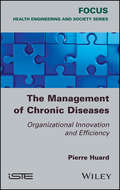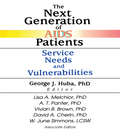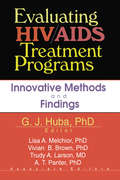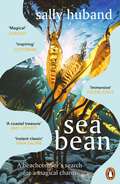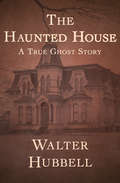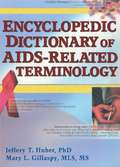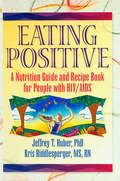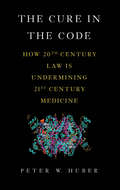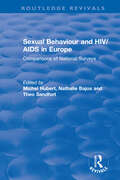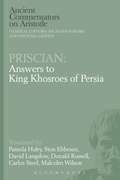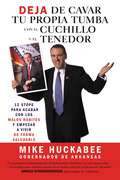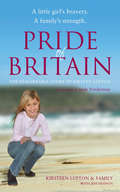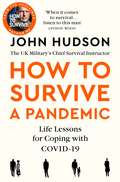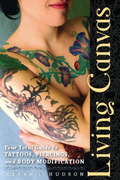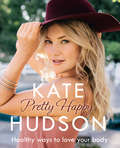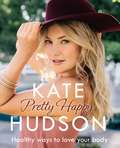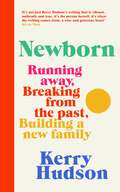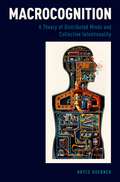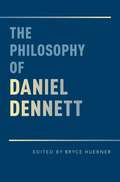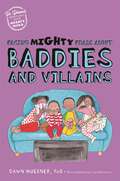- Table View
- List View
The Management of Chronic Diseases: Organizational Innovation and Efficiency
by Pierre HuardThis book aims to redefine the requirements of an effective care for the chronic diseases, and their difficulties of implementation; to analyze the processes allowing to reinforce quality and to contain the costs and the expenditure related to this care; and to release the dynamic processes of development of an efficient care, the organisational forms and the corresponding strategies.
The Next Generation of AIDS Patients: Service Needs and Vulnerabilities
by George J Huba Vivian BrownGo beyond traditional medical care to treat the whole person!In the past ten years, the treatment and epidemiology of AIDS have changed, and HIV/AIDS services must also change. The Next Generation of AIDS Patients suggests new ways to find and care for persons living with AIDS, not just by offering traditional medical treatment but by delivering needed support services as well. This landmark book defines the startling shift in demographics of this phase of the epidemic. The new AIDS patients have different problems than the white gay men who were strongly affected in the early days of the disease: some are substance abusers or sex workers or their partners, and many have children. Clients who are homeless, poorly educated, not native English speakers, or uninsured have overwhelming social support needs and need extra help to obtain their medical requirements. The Next Generation of AIDS Patients offers detailed analyses to help you determine clients’needs and vulnerability levels, so you can provide complete biopsychosocial services. In addition, the original empirical research in this book reveals which programs deliver the best outcomes for various client populations. The Next Generation of AIDS Patientssupplies you with an effective data modeling approach for determining levels of vulnerability and need, and discusses such vital issues as: identifying and overcoming barriers to HIV care engaging and retaining in care individuals with high levels of unmet need delivering services to diverse minority populations, substance abusers, homeless people, and those who live in rural areas client satisfaction in community service organizationsIn order to develop successful community-based health care and support services, medical and social work professionals must take the new face of this disease into account. The Next Generation of AIDS Patients offers practical advice, readily applicable theory, and proven strategies for caring for people living with AIDS.
The Next Generation of AIDS Patients: Service Needs and Vulnerabilities
by George J Huba Vivian BrownGo beyond traditional medical care to treat the whole person!In the past ten years, the treatment and epidemiology of AIDS have changed, and HIV/AIDS services must also change. The Next Generation of AIDS Patients suggests new ways to find and care for persons living with AIDS, not just by offering traditional medical treatment but by delivering needed support services as well. This landmark book defines the startling shift in demographics of this phase of the epidemic. The new AIDS patients have different problems than the white gay men who were strongly affected in the early days of the disease: some are substance abusers or sex workers or their partners, and many have children. Clients who are homeless, poorly educated, not native English speakers, or uninsured have overwhelming social support needs and need extra help to obtain their medical requirements. The Next Generation of AIDS Patients offers detailed analyses to help you determine clients’needs and vulnerability levels, so you can provide complete biopsychosocial services. In addition, the original empirical research in this book reveals which programs deliver the best outcomes for various client populations. The Next Generation of AIDS Patientssupplies you with an effective data modeling approach for determining levels of vulnerability and need, and discusses such vital issues as: identifying and overcoming barriers to HIV care engaging and retaining in care individuals with high levels of unmet need delivering services to diverse minority populations, substance abusers, homeless people, and those who live in rural areas client satisfaction in community service organizationsIn order to develop successful community-based health care and support services, medical and social work professionals must take the new face of this disease into account. The Next Generation of AIDS Patients offers practical advice, readily applicable theory, and proven strategies for caring for people living with AIDS.
Evaluating HIV/AIDS Treatment Programs: Innovative Methods and Findings
by George J Huba Lisa A Melchior Vivian Brown A.T. Panter Trudy A Larson Pauline FitzpatrickCreate effective community-based programs for substance abusers with HIV/AIDS!Substance abusers are the fastest-growing population of people with HIV/AIDS in the US--and one of the hardest to reach and treat. Evaluating HIV/AIDS Treatment Programs offers new strategies for providing care for this vulnerable population. The programs evaluated and discussed in this volume were funded as part of the DHHS Health Resources and Services Administration through its Special Projects of National Significance Program. Collectively known as the SPNS Cooperative Agreement, these 27 projects represent a diverse group of organizations with a common goal: to improve the health, quality of life, and access to health care for traditionally underserved populations living with HIV/AIDS.Evaluating HIV/AIDS Treatment Programs reports in detail the efforts of several community-based HIV/AIDS organizations in the SPNS program. You will learn how these organizations provide high-quality care for persons with HIV who are unlikely to obtain it in the traditional hospital-based service system. This volume offers specific, proven strategies designed to overcome the linguistic, cultural, racial, and economic barriers that make it difficult for some sick people to get the health care they need. It also offers specialized medical care models that work within the context of a continuum of services in a medical clinic.Evaluating HIV/AIDS Treatment Programs also highlights other aspects of the Cooperative Agreement projects, including: a study of end-stage AIDS care an overview of the HRSA HIV/AIDS Bureau SPNS Cooperative Agreement grant initiative a study of conceptual issues in implementing program evaluation in real-world community organizations discussion of the online Knowledge Base that summarizes and disseminates information from the Cooperative Agreement projects studies of ways to reach and care for specific populations with HIV/AIDS, including women, Latinos, Haitians, adolescents, and rural peopleThis valuable volume offers solid data on treating people who are all too often neglected by the medical community even before they contract HIV/AIDS. The programs and ideas presented in Evaluating HIV/AIDS Treatment Programs can be applied to other community-based health initiatives and clinics offering medical care to underserved and vulnerable populations. This essential resource deserves a permanent place on their bookshelf of any physician, administrator, or policymaker working in the fields of HIBV/AIDS, epidemiology, public health, or substance abuse. Visit the book's website at http://www.TheMeasurementGroup.com/drugs_and_society.htm
Evaluating HIV/AIDS Treatment Programs: Innovative Methods and Findings
by George J Huba Lisa A Melchior Vivian Brown A.T. Panter Trudy A Larson Pauline FitzpatrickCreate effective community-based programs for substance abusers with HIV/AIDS!Substance abusers are the fastest-growing population of people with HIV/AIDS in the US--and one of the hardest to reach and treat. Evaluating HIV/AIDS Treatment Programs offers new strategies for providing care for this vulnerable population. The programs evaluated and discussed in this volume were funded as part of the DHHS Health Resources and Services Administration through its Special Projects of National Significance Program. Collectively known as the SPNS Cooperative Agreement, these 27 projects represent a diverse group of organizations with a common goal: to improve the health, quality of life, and access to health care for traditionally underserved populations living with HIV/AIDS.Evaluating HIV/AIDS Treatment Programs reports in detail the efforts of several community-based HIV/AIDS organizations in the SPNS program. You will learn how these organizations provide high-quality care for persons with HIV who are unlikely to obtain it in the traditional hospital-based service system. This volume offers specific, proven strategies designed to overcome the linguistic, cultural, racial, and economic barriers that make it difficult for some sick people to get the health care they need. It also offers specialized medical care models that work within the context of a continuum of services in a medical clinic.Evaluating HIV/AIDS Treatment Programs also highlights other aspects of the Cooperative Agreement projects, including: a study of end-stage AIDS care an overview of the HRSA HIV/AIDS Bureau SPNS Cooperative Agreement grant initiative a study of conceptual issues in implementing program evaluation in real-world community organizations discussion of the online Knowledge Base that summarizes and disseminates information from the Cooperative Agreement projects studies of ways to reach and care for specific populations with HIV/AIDS, including women, Latinos, Haitians, adolescents, and rural peopleThis valuable volume offers solid data on treating people who are all too often neglected by the medical community even before they contract HIV/AIDS. The programs and ideas presented in Evaluating HIV/AIDS Treatment Programs can be applied to other community-based health initiatives and clinics offering medical care to underserved and vulnerable populations. This essential resource deserves a permanent place on their bookshelf of any physician, administrator, or policymaker working in the fields of HIBV/AIDS, epidemiology, public health, or substance abuse. Visit the book's website at http://www.TheMeasurementGroup.com/drugs_and_society.htm
Sea Bean
by Sally HubandA WATERSTONES NATURE AND TRAVEL BEST BOOK OF 2023LONGLISTED FOR THE WAINWRIGHT NATURE WRITING PRIZE 2023'Modern, revealing and restorative, a coastal treasure' Amy Liptrot'Like its talismanic title, Huband's voice is distinct and singular. A gorgeous reckoning with the sea, islands and mythology' Sinéad Gleeson'A wild melding of body and landscape. A deep, immersive, storm-tossed read' Helen Jukes'As vital and complex as the oceans themseleves' Joanna PocockA powerful journey of sea and self, trial and hope on the islands of ShetlandOn the storm-tossed beaches of the Shetland Archipelago, Sally Huband is searching. A message in a bottle, a mermaid’s purse, a lobster trap tag, each find connects her more deeply with our oceans. But it is Sally’s quest for a fabled sea bean that unlocks the myths of these islands and carries her through chronic illness towards a new and more resilient self.
The Haunted House
by Walter HubbellThe blood-chilling true story of a nineteenth-century girl’s terrifying and bewildering haunting First published in 1879, The Haunted House: A True Ghost Story is the author’s account of the infamous haunting of eighteen-year-old Esther Cox, who lived with her extended family in Amherst, Nova Scotia—a beautiful, peaceful little village, population three thousand—during the late 1800s. Walter Hubbell stayed with the family for six weeks, during which he witnessed a variety of alternately compelling and terrifying paranormal and unexplained events. As he describes these manifestations: No person has yet been able to ascertain their cause. Scientific men from all parts of Canada and the United States have investigated them in vain. Some people think that electricity is the principal agent; others, mesmerism; whilst others again, are sure they are produced by the devil. Of the three supposed causes, the latter is certainly the most plausible theory, for some of the manifestations are remarkably devilish in their appearance and effect. For instance, the mysterious setting of fires, the powerful shaking of the house, the loud and incessant noises and distinct knocking, as if made by invisible sledge-hammers, on the walls; also, the strange actions of the household furniture, which moves about in the broad daylight without the slightest visible cause. This ebook has been professionally proofread to ensure accuracy and readability on all devices.
Encyclopedic Dictionary of AIDS-Related Terminology
by Jeffrey T Huber Mary L GillaspyMake sense out of confusing HIV/AIDS terminology!Finally, here is a reference work that contains clear and useful definitions of words, phrases, and medical terms associated with HIV/AIDS! The Encyclopedic Dictionary of AIDS-Related Terminology is an easy-to-understand guide to all of the mainstream jargon surrounding this epidemic. This user-friendly volume brings you a number of essential features, such as: popular and scientific names of conditions and medicines listings of addresses and contact information for organizations and government agencies that are concerned with HIV/AIDS definitions of historical terms, abbreviations, and acronyms related to HIV/AIDS details of corporate and organizational involvement with HIV/AIDS research, prevention, and interventionThe Encyclopedic Dictionary of AIDS-Related Terminology also includes entries that describe and relate to legal, social, psychological, and religious issues, not just medical terms, to give readers a complete source that will meet all of their needs. With this single resource, you will be able to easily and thoroughly understand the sometimes complex jargon associated with HIV/AIDS. For librarians, AIDS service organizations, people living with AIDS, and the general public, the Encyclopedic Dictionary of AIDS-Related Terminology is a comprehensive guide to conditions and medical terms associated with HIV/AIDS. Dates, histories, addresses, telephone numbers, and Web site addresses are included with many entries.Including words specific to the epidemic as well as related psychosocial phrases, this essential volume offers you definitions of HIV/AIDS medications and listings of organizations and government agencies that are concerned with the disease.
Encyclopedic Dictionary of AIDS-Related Terminology
by Jeffrey T Huber Mary L GillaspyMake sense out of confusing HIV/AIDS terminology!Finally, here is a reference work that contains clear and useful definitions of words, phrases, and medical terms associated with HIV/AIDS! The Encyclopedic Dictionary of AIDS-Related Terminology is an easy-to-understand guide to all of the mainstream jargon surrounding this epidemic. This user-friendly volume brings you a number of essential features, such as: popular and scientific names of conditions and medicines listings of addresses and contact information for organizations and government agencies that are concerned with HIV/AIDS definitions of historical terms, abbreviations, and acronyms related to HIV/AIDS details of corporate and organizational involvement with HIV/AIDS research, prevention, and interventionThe Encyclopedic Dictionary of AIDS-Related Terminology also includes entries that describe and relate to legal, social, psychological, and religious issues, not just medical terms, to give readers a complete source that will meet all of their needs. With this single resource, you will be able to easily and thoroughly understand the sometimes complex jargon associated with HIV/AIDS. For librarians, AIDS service organizations, people living with AIDS, and the general public, the Encyclopedic Dictionary of AIDS-Related Terminology is a comprehensive guide to conditions and medical terms associated with HIV/AIDS. Dates, histories, addresses, telephone numbers, and Web site addresses are included with many entries.Including words specific to the epidemic as well as related psychosocial phrases, this essential volume offers you definitions of HIV/AIDS medications and listings of organizations and government agencies that are concerned with the disease.
Eating Positive: A Nutrition Guide and Recipe Book for People with HIV/AIDS
by Jeffrey T Huber Kris RiddlespergerProper nutrition is essential to individuals with HIV/AIDS. Yet, it is often difficult to maintain an adequate diet due to a variety of conditions associated with the disease and/or medications used to alleviate symptoms. Eating Positive: A Nutrition Guide and Recipe Book for People with HIV/AIDS solves this problem with easy-to-follow, enticing recipes that fit a variety of common diet restrictions and specific health needs of individuals with HIV/AIDS. You can use this practical nutrition guide and recipe book to customize diet plans for your patients or for yourself (with a doctor’s approval) that provide proper nutrition and satisfy the tastebuds.Chapters in Eating Positive are organized by diet type. Each chapter describes the diet type, its benefits and specific restrictions, and actual recipes. Each recipe is accompanied by its respective nutritional values, such as calories, fat, protein, carbohydrates, and percent of daily recommended allowance. An alphabetical index consisting of specific conditions, complications, diet titles, and food stuffs provides ease of use and quick reference. Here is just a sample of some of the many diet types, their benefits, and tasty recipes that are included:Full Liquid Diet: good for people with mouth pain and difficulty chewing as it is easy on the digestive system; recipes include: Orange Cow, Easy Egg Drop Soup, Cherry Dessert, Cottage Cheese Jello Salad, Tropical Frozen Delight, more Fiber Restricted Diet: slows bowel movement and decreases inflammation of the tissues making it a great ally in fighting diarrhea and bowel discomfort; recipes include: Sauteed Cocktail Tomatoes, Bacon Wrapped Chicken Breasts, Vegetarian Stuffed Peppers, Ham Rolls with Eggplant Filling, more Bland Diet: for those who should avoid caffeine, alcohol, spices; recipes include: Raspberry Float, Pasta Salad, Easy Tortellini Soup, One-Eyed Egyptians, Noodle Pudding, Watercress Soup, Sour Cream Coffee Cake, German Potato Dumplings, more High Protein High Calorie Diet: increased calories and nutritional content build up energy resources and assist in improving and maintaining the immune system, stopping and possibly reversing tissue wasting and weight loss and assisting in wound healing; recipes include: Garlic Pasta, Beef and Rice Creole, Spinach Cheese Pie, Tournedos of Beef with Shallot Sauce, Banana Nut Bread, Butterscotch Pie, Pineapple Coconut Cake, many moreThese diets are not prescriptions but rather guides for creating and consuming a practical diet to suit individual needs. You’ll find that Eating Positive puts individuals with HIV/AIDS on the road to a more pleasing, fulfilling, and healthy diet.
Eating Positive: A Nutrition Guide and Recipe Book for People with HIV/AIDS
by Jeffrey T Huber Kris RiddlespergerProper nutrition is essential to individuals with HIV/AIDS. Yet, it is often difficult to maintain an adequate diet due to a variety of conditions associated with the disease and/or medications used to alleviate symptoms. Eating Positive: A Nutrition Guide and Recipe Book for People with HIV/AIDS solves this problem with easy-to-follow, enticing recipes that fit a variety of common diet restrictions and specific health needs of individuals with HIV/AIDS. You can use this practical nutrition guide and recipe book to customize diet plans for your patients or for yourself (with a doctor’s approval) that provide proper nutrition and satisfy the tastebuds.Chapters in Eating Positive are organized by diet type. Each chapter describes the diet type, its benefits and specific restrictions, and actual recipes. Each recipe is accompanied by its respective nutritional values, such as calories, fat, protein, carbohydrates, and percent of daily recommended allowance. An alphabetical index consisting of specific conditions, complications, diet titles, and food stuffs provides ease of use and quick reference. Here is just a sample of some of the many diet types, their benefits, and tasty recipes that are included:Full Liquid Diet: good for people with mouth pain and difficulty chewing as it is easy on the digestive system; recipes include: Orange Cow, Easy Egg Drop Soup, Cherry Dessert, Cottage Cheese Jello Salad, Tropical Frozen Delight, more Fiber Restricted Diet: slows bowel movement and decreases inflammation of the tissues making it a great ally in fighting diarrhea and bowel discomfort; recipes include: Sauteed Cocktail Tomatoes, Bacon Wrapped Chicken Breasts, Vegetarian Stuffed Peppers, Ham Rolls with Eggplant Filling, more Bland Diet: for those who should avoid caffeine, alcohol, spices; recipes include: Raspberry Float, Pasta Salad, Easy Tortellini Soup, One-Eyed Egyptians, Noodle Pudding, Watercress Soup, Sour Cream Coffee Cake, German Potato Dumplings, more High Protein High Calorie Diet: increased calories and nutritional content build up energy resources and assist in improving and maintaining the immune system, stopping and possibly reversing tissue wasting and weight loss and assisting in wound healing; recipes include: Garlic Pasta, Beef and Rice Creole, Spinach Cheese Pie, Tournedos of Beef with Shallot Sauce, Banana Nut Bread, Butterscotch Pie, Pineapple Coconut Cake, many moreThese diets are not prescriptions but rather guides for creating and consuming a practical diet to suit individual needs. You’ll find that Eating Positive puts individuals with HIV/AIDS on the road to a more pleasing, fulfilling, and healthy diet.
The Cure in the Code: How 20th Century Law is Undermining 21st Century Medicine
by Peter W. HuberNever before have two revolutions with so much potential to save and prolong human life occurred simultaneously. The converging, synergistic power of the biochemical and digital revolutions now allows us to read every letter of life's code, create precisely targeted drugs to control it, and tailor their use to individual patients. Cancer, diabetes, Alzheimer's and countless other killers can be vanquished-if we make full use of the tools of modern drug design and allow doctors the use of modern data gathering and analytical tools when prescribing drugs to their patients.But Washington stands in the way, clinging to outdated drug-approval protocols developed decades ago during medicine's long battle with the infectious epidemics of the past. Peter Huber, an expert in science, technology, and public policy, demonstrates why Washington's one-size-fits-all drug policies can't deal with diseases rooted in the complex molecular diversity of human bodies. Washington is ill-equipped to handle the torrents of data that now propel the advance of molecular medicine and is reluctant to embrace the statistical methods of the digital age that can. Obsolete economic policies, often rationalized as cost-saving measures, stifle innovation and suppress investment in the medicine that can provide the best cures at the lowest cost.In the 1980s, an AIDS diagnosis was a death sentence, until the FDA loosened its throttling grip and began streamlining and accelerating approval of life-saving drugs. The Cure in the Code shows patients, doctors, investors, and policy makers what we must now do to capture the full life-saving and cost-saving potential of the revolution in molecular medicine. America has to choose. At stake for America is the power to lead the world in mastering the most free, fecund, competitive, dynamic, and intelligent natural resource on the planet-the molecular code that spawns human life and controls our health.
Sexual Behaviour and HIV/AIDS in Europe: Comparisons of National Surveys (Routledge Revivals)
by Michel Hubert Nathalie Bajos Theo SandfortOriginally published in 1998 Sexual Behaviour and HIV/AIDS in Europe is detailed study comparing the major population surveys on sexual behaviour and HIV/AIDS carried out in Europe at the time of publication. Leading European researchers explore the differences and similarities between European countries in patterns of sexual behaviour and responses to the HIV/AIDS epidemic. As well as providing an empirical and methodological base for future research, the comparative analyses lead researchers, policy makers, health-educators and the media to new insights and a deeper understanding of issues that are of central concern in many countries. The chapters include discussion of data on sexual initiation, homosexual and bisexual behaviour, sexual practices, sexual partners, risk behaviour, STDs, preventive practices, the normative context, knowledge of HIV/AIDS, and attitudes towards people with HIV/AIDS. The book results from a major European Concerted Action, funded by the European Union Biomedical and Health Research programme (BIOMED), and coordinated by the Centre d'Etudes Sociologiques of the Facultes Universitaires Saint-Louis, Brussels, Belgium. It follows Sexual Interactions and HIV Risk, published in 1997.
Priscian: Answers To King Khosroes Of Persia (Ancient Commentators on Aristotle)
by Pamela Huby Sten Ebbesen David Langslow Donald Russell Richard Sorabji Carlos Steel Malcolm WilsonPriscian of Lydia was one of the Athenian philosophers who took refuge in 531 AD with King Khosroes I of Persia, after the Christian Emperor Justinian stopped the teaching of the pagan Neoplatonist school in Athens. This was one of the earliest examples of the sixth-century diffusion of the philosophy of the commentators to other cultures.Tantalisingly, Priscian fully recorded in Greek the answers provided by the Athenian philosophers to the king's questions on philosophy and science. But these answers survive only in a later Latin translation which understood both the Greek and the subject matter very poorly. Our translators have often had to reconstruct from the Latin what the Greek would have been, in order to recover the original sense. The answers start with subjects close to the Athenians' hearts: the human soul, on which Priscian was an expert, and sleep and visions. But their interest may have diminished when the king sought their expertise on matters of physical science: the seasons, celestial zones, medical effects of heat and cold, the tides, displacement of the four elements, the effect of regions on living things, why only reptiles are poisonous, and winds. At any rate, in 532 AD, they moved on from the palace, but still under Khosroes' protection. This is the first translation of the record they left into English or any modern language.This English translation is accompanied by an introduction and comprehensive commentary notes, which clarify and discuss the meaning and implications of the original philosophy. Part of the Ancient Commentators on Aristotle series, the edition makes this philosophical work accessible to a modern readership and includes additional scholarly apparatus such as a bibliography, glossary of translated terms and a subject index.
Priscian: Answers to King Khosroes of Persia (Ancient Commentators on Aristotle)
by Pamela Huby Sten Ebbesen David Langslow Donald Russell Carlos Steel Malcolm WilsonPriscian of Lydia was one of the Athenian philosophers who took refuge in 531 AD with King Khosroes I of Persia, after the Christian Emperor Justinian stopped the teaching of the pagan Neoplatonist school in Athens. This was one of the earliest examples of the sixth-century diffusion of the philosophy of the commentators to other cultures.Tantalisingly, Priscian fully recorded in Greek the answers provided by the Athenian philosophers to the king's questions on philosophy and science. But these answers survive only in a later Latin translation which understood both the Greek and the subject matter very poorly. Our translators have often had to reconstruct from the Latin what the Greek would have been, in order to recover the original sense. The answers start with subjects close to the Athenians' hearts: the human soul, on which Priscian was an expert, and sleep and visions. But their interest may have diminished when the king sought their expertise on matters of physical science: the seasons, celestial zones, medical effects of heat and cold, the tides, displacement of the four elements, the effect of regions on living things, why only reptiles are poisonous, and winds. At any rate, in 532 AD, they moved on from the palace, but still under Khosroes' protection. This is the first translation of the record they left into English or any modern language.This English translation is accompanied by an introduction and comprehensive commentary notes, which clarify and discuss the meaning and implications of the original philosophy. Part of the Ancient Commentators on Aristotle series, the edition makes this philosophical work accessible to a modern readership and includes additional scholarly apparatus such as a bibliography, glossary of translated terms and a subject index.
Quit Digging Your Grave with a Knife and Fork: A 12-Stop Program to End Bad Habits and Begin a Healthy Lifestyle
by Mike HuckabeeNow available in Spanish, the bestselling book in which a leaner Arkansas Governor Mike Huckabee shares his secrets for creating better health habits that last a lifetime.
Pride of Britain: A Little Girl's Bravery. A Family's Strength.
by Jeff Hudson Martin LuptonKirsteen Lupton seems like any other teenage girl. But Kirsteen was born with a rare medical condition: her bladder was on the outside of her body. By the age of seven she had endured numerous agonising, failed operations. After medical complications left her weighing just 1½ stone and battling for her life, surgery by the team at Great Ormond Street Hospital finally gave her a chance at a normal life. What makes Kirsteen so exceptional is that she has since helped to raise over £750,000 for the hospital. In 2006 she was named 'Fundraiser of the Year' at the Pride of Britain awards.This is the story of Kirsteen's extraordinary life and her work to raise funds for the hospital that helped her so much. But it is also the story of her family, who have always supported her - her mum, who battled with feelings of guilt over Kirsteen's condition, her dad, who sacrificed career advancement and earning capacity to look after his family, and her brothers, who have watched as their parents struggled to support their sister.
How to Survive a Pandemic: Life Lessons for Coping with Covid-19
by John HudsonLife-changing moments can happen at any time and anywhere – not just in the extreme world. But life-changing moments can also happen more gradually and, as we’ve seen with the current pandemic, it can be no less of a shock when the realization comes. Accepting this and taking responsibility increases your ability to tolerate hardship and to restart your perseverance engine. This is the key to your survival mindset and one of the greatest skills to develop in life.In How to Survive a Pandemic, acclaimed author and the UK Military's Chief Survival Instructor, John Hudson provides the key elements needed for us to cope with a pandemic - how to prepare rather than panic. From understanding that mindset is key and staying informed and make the right decisions, to practical advice on how to know your enemy, and defend your vulnerabilities, this free eBook is the perfect guide for coping with the COVID-19 pandemic we are currently facing, and how to come out of self-isolation stronger and wiser.This is a free eBook and will appear as an appendix to How to Survive: Lessons for Everyday Life from the Extreme World, published in paperback on 28th May, 2020.
Living Canvas: Your Total Guide to Tattoos, Piercings, and Body Modification
by Karen HudsonTattoos. Given their permanence, why is it that we sometimes put more thought into what we’ll wear next Saturday night, or our next haircut? As a tattoo specialist and writer for About.com, Karen L. Hudson has talked to far too many people who regret their tattoos. After years of fielding questions and concerns about tattoo health, she realized the need for a book that would cover all the bases of body art-from planning and choosing an artist to how to take care of your new piercing or tattoo afterwards. Living Canvas is a resource for body art enthusiasts, whether you’re thinking about getting your first or fifth tattoo, planning for your next bod-mod, or regretting a negative experience. Transforming one’s body into a living canvas should not be taken lightly, and Hudson covers the topics that too many people overlook. Encouraging readers to make safe, smart body art choices, Living Canvas is informative, preventative, and educational.
Pretty Happy: The Healthy Way To Love Your Body
by Kate HudsonA smart health and fitness bible from inspirational actress Kate Hudson.
Pretty Happy: The Healthy Way To Love Your Body
by Kate HudsonA smart health and fitness bible from inspirational actress Kate Hudson.
Newborn: Running Away, Breaking with the Past, Building a New Family
by Kerry Hudson‘It was always going to be difficult to follow Lowborn, but Kerry Hudson is Kerry Hudson and she has done it – cleverly, honestly, brilliantly’ RODDY DOYLE'Filled with colour: food, Prague, illness, love, the challenges of having a baby in a foreign country and making your own story' AMY LIPTROTIn Newborn, prizewinning writer Kerry Hudson navigates trying to build a nourishing, safe and loving family - without a blueprint to work fromKerry Hudson is celebrated for her emotionally and politically powerful writing about growing up in poverty. Her books and journalism have changed the conversation and touched countless lives.In this new book she asks: what next, after a childhood like hers? What hope is there of creating a different life for herself, let alone future generations? We see how Kerry found love, what it took to decide to start a family of her own and how fragile every step of the journey towards parenthood was. All along the way, she faces obstacles that would test the strongest foundations, from struggles with fertility to being locked down in a Prague maternity hospital to a marriage in crisis. But over and over again, her love, hope, fight -- and determination to break patterns and give her son a different life -- win through and light her path.Newborn is a beautiful, empowering memoir about creating a family in the midst of chaos, and learning new ways to find happiness. It continues the journey Kerry started in her bestselling memoir Lowborn, illuminating her experiences of becoming a mother, reshaping her future and reclaiming her identity.PRAISE FOR KERRY HUDSON:‘It’s not just Kerry Hudson’s writing that is vibrant, authentic and true, it’s the person herself, it’s where the writing comes from; a wise and generous heart’ KIT DE WAAL'Hudson’s resilience, grace and humility are staggering. She’s an absolute inspiration’ DOUGLAS STUART‘Kerry Hudson blew me away, opened my eyes’ PHILIPPA PERRY
Macrocognition: A Theory of Distributed Minds and Collective Intentionality
by Bryce HuebnerWe live in an age of scientific collaboration, popular uprisings, failing political parties, and increasing corporate power. Many of these kinds of collective action derive from the decisions of intelligent and powerful leaders, and many others emerge as a result of the aggregation of individual interests. But genuinely collective mentality remains a seductive possibility. This book develops a novel approach to distributed cognition and collective intentionality. It argues that genuine cognition requires the capacity to engage in flexible goal-directed behavior, and that this requires specialized representational systems that are integrated in a way that yields fluid and skillful coping with environmental contingencies. In line with this argument, the book claims that collective mentality should be posited where and only where specialized subroutines are integrated to yields goal-directed behavior that is sensitive to the concerns that are relevant to a group as such. Unlike traditional claims about collective intentionality, this approach reveals that there are many kinds of collective minds: some groups have cognitive capacities that are more like those that we find in honeybees or cats than they are like those that we find in people. Indeed, groups are unlikely to be "believers" in the fullest sense of the term, and understanding why this is the case sheds new light on questions about collective intentionality and collective responsibility.
The Philosophy of Daniel Dennett
by Bryce HuebnerDaniel C. Dennett began publishing innovative philosophical research in the late 1960s, and he has continued to do so for the past 45 years. He has addressed questions about the nature of mind and consciousness, the possibility of freedom, and the significance of evolution to addressing questions across the cognitive, biological, and social sciences. The Philosophy of Daniel Dennett explores the intellectual significance of this research project, bringing together the insights of eleven researchers who are currently working on themes that are relevant to Dennett's philosophical worldview. Some of the contributions address interpretive issues within Dennett's corpus, and aim to bring increased clarity to Dennett's project. Others report novel empirical data, at least in part, in the service of fleshing out Dennett's claims. Some of them provide a fresh take on a Dennettian theme, and others extend his views in novel directions. Like Dennett's own work, these papers draw on a wide range of different methodologies, from appeals to intuition pumps and scientific data, to turning the knobs on a theory to see what it can do. But each of them aims to be readable, and approachable. And as a whole, the volume provides a critical and constructive overview of Dennett's stance-based methodology, as well as explorations of his claims about metal representation, consciousness, cultural evolution, and religion.
Facing Mighty Fears About Baddies and Villains (Dr. Dawn's Mini Books About Mighty Fears #5)
by Dawn HuebnerMany children are afraid of baddies and villains who do, in fact, do hurtful things. But sometimes fear far outstrips danger, and even children who are safe feel apprehensive all the time. Facing Mighty Fears About Baddies and Villains teaches 3 steps to help manage ongoing fears. Fun Facts engage children, while a Note to Parents and Caregivers and supplemental Resource section make this the perfect guide for parents and mental health professionals.This book is part of the Dr. Dawn's Mini Books About Mighty Fears series, designed to help children ages 6-10 tackle their fears and live happier lives.
